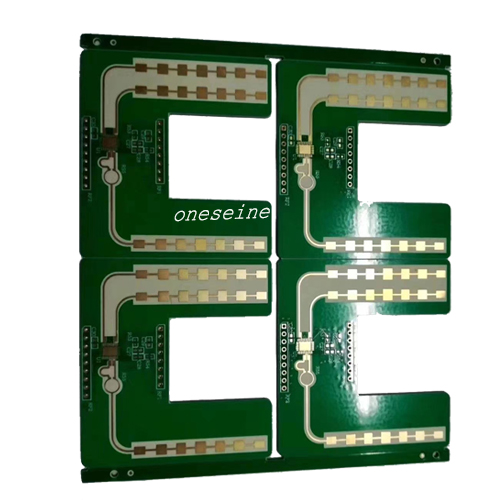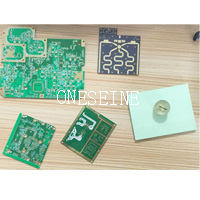Rogers PCB
5.8GHZ Rogers PCB Material Properties High Frequency Board
- rogers circuit board
- rogers dielectric materials
- rogers pcb cheap price
- rogers pcb board
- Product description: rogers pcb rogers 4350b rogers pcb material ro4350b rogers 4350 rogers pcb manufacturers rogers ro4350b rogers pcb fabrication rogers pcb price rogers 4003 rogers pcb material properties ro
5.8GHZ Rogers PCB Material Properties High Frequency Board
PCB specification:
Material: RO4350B
Number of layers: 4
Plate thickness: 0.254mm
Minimum aperture: Mechanical hole 0.2mm,
Minimum line width/line spacing: 0.35mm
Copper thickness: 1OZ each on the inner and outer layers
Solder resistance: green oil with white letters
Surface technology: sinking gold
Top of the line high-frequency material resources, allowing your products to win at the fundamental factory. We have imported and domestic boards with dielectric constants ranging from 2.2 to 10.6. High frequency materials such as Rogers/Rogers, Taconic/Taikonli, Arlon, Isola, F4BM/Wangling, PTFE/PTFE, TP-2, etc., with dielectric constants ranging from 2.2 to 10.6. Rogers series: RogersRO4350B, RO4003C, RT5880, RT5870, RO3003, RO3010, RO4730, RT6006, RT6010, etc
Here are some key points about 5.8GHz PCB boards:
- Frequency Range: 5.8GHz is part of the unlicensed 5GHz frequency band, which ranges from 5.15GHz to 5.85GHz. This band is commonly used for Wi-Fi, WLAN, and other wireless communications.
- Applications: 5.8GHz PCB boards are often used in wireless networking equipment, point-to-point wireless links, satellite communications, radar systems, and other high-frequency RF/microwave devices.
- Design Considerations: Designing PCBs for 5.8GHz operation requires careful attention to factors like trace width, layer stackup, component placement, and impedance matching. The small wavelengths at this frequency make the board layout critical for proper signal integrity.
- Challenges: Some key challenges include high signal attenuation, increased electromagnetic interference (EMI), and the need for specialized components that can operate reliably at 5.8GHz. Thermal management is also more crucial at these high frequencies.
- Materials: 5.8GHz PCBs often use low-loss dielectric materials like Rogers RO4350B, RO3003, or RF-35. Careful material selection is important to minimize signal degradation.
- Manufacturing: Fabricating 5.8GHz boards requires tight manufacturing tolerances and specialized equipment compared to lower frequency PCBs. Careful quality control is essential.
Can you provide some examples of common 5.8GHz wireless applications?
1. Wi-Fi and WLAN:
- 802.11ac and 802.11ax (Wi-Fi 5 and 6) wireless access points and routers often operate in the 5.8GHz band to provide high-speed wireless networking.
- 5.8GHz is one of the primary frequency bands used for high-bandwidth wireless local area networks (WLANs) in homes, offices, and public hotspots.
2. Point-to-Point Wireless Backhaul:
- 5.8GHz is widely used for wireless backhaul links between cellular towers, buildings, and other infrastructure to provide high-capacity data connectivity.
- These point-to-point links can offer gigabit-level throughput over distances of several kilometers.
3. Surveillance and Security Systems:
- 5.8GHz wireless cameras and video links are commonly used in security and surveillance applications, such as in industrial facilities, cities, and transportation hubs.
- The high frequency provides good bandwidth for transmitting high-resolution video feeds.
4. Satellite Communications:
- 5.8GHz is utilized for satellite uplink and downlink frequencies in certain satellite communications systems, particularly for data and video transmission.
5. Radar and Sensing Applications:
- The 5.8GHz band is used for radar systems in applications like automotive collision avoidance, weather monitoring, and industrial process control.
- The high frequency enables precise, high-resolution sensing and imaging capabilities.
6. Military and Aerospace:
- 5.8GHz wireless links are employed in various military and aerospace applications, such as tactical communications, unmanned aerial vehicles (UAVs), and electronic warfare systems.
So in summary, the 5.8GHz frequency band is widely utilized for high-speed wireless communications, backhaul, sensing, and specialized applications that require high bandwidth and precision.
How does the 5.8GHz band compare to the 2.4GHz band in terms of performance and applications?
The 5.8GHz band and the 2.4GHz band each have their own advantages and tradeoffs when it comes to wireless performance and applications. Here's a comparison:
Frequency:
- 5.8GHz has a higher frequency than 2.4GHz, with a shorter wavelength.
- Higher frequencies allow for smaller antennas and more spatial multiplexing, enabling higher data rates.
Bandwidth:
- The 5.8GHz band has more available bandwidth than the crowded 2.4GHz ISM band.
- This allows 5.8GHz systems to support higher throughputs, especially for high-bandwidth applications like video streaming.
Range and Penetration:
- 2.4GHz signals have better range and can penetrate obstacles like walls more effectively than 5.8GHz.
- 5.8GHz signals tend to be more line-of-sight and have shorter range, especially in indoor environments.
Interference:
- The 2.4GHz band is more crowded and suffers from more interference from devices like microwave ovens and Bluetooth.
- 5.8GHz has fewer interfering devices and provides a cleaner spectrum for wireless communications.
Power Consumption:
- 5.8GHz systems generally require more power than 2.4GHz due to the higher frequencies.
- This makes 2.4GHz more suitable for battery-powered IoT devices and low-power applications.
Applications:
- 2.4GHz is widely used for general-purpose wireless networking, IoT, and legacy Wi-Fi.
- 5.8GHz is more commonly used for high-bandwidth applications like high-speed Wi-Fi, point-to-point links, and radar/sensing systems.
In summary, the 5.8GHz band offers greater bandwidth and throughput, but has reduced range and penetration compared to 2.4GHz. The choice between the two bands often depends on the specific performance requirements and use case of the wireless system.
Categories
Latest News
Contact Us
Contact: Ms Tracy
Phone:
Tel:
Add: BludingA,Shixiaganglian Industrial Park,Shajing,Baoan,Shenzhen,China




 Tracy
Tracy